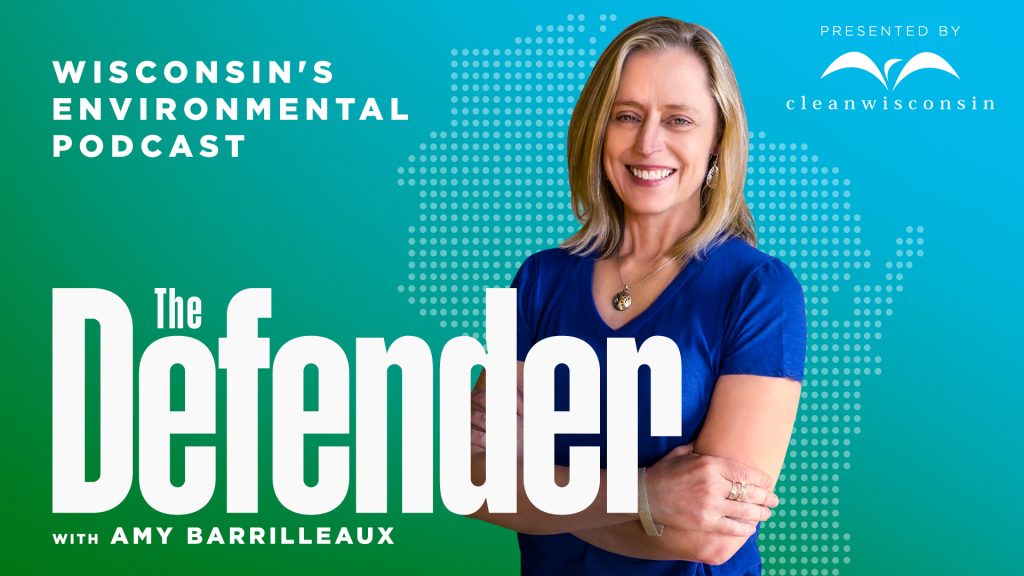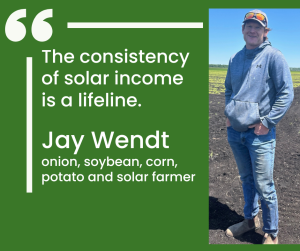It’s no secret, Wisconsin has been rapidly losing its small family farms, and with them, a way of life that’s defined much of our state for more than a century. But there is a lifeline coming.
About 30 miles outside of Lake Geneva, Amy meets Jay Wendt to take a long walk on a farm that’s been in his wife’s family for decades. These days, the family is joining farmers across Wisconsin who are choosing to lease some of their land for solar.
Where to Listen:
Host:
Amy Barrilleaux
Guest:
Jay Wendt, farmer, Dean Kincaid, Inc.
Background Reading:
Analysis reveals solar farms produce 100 times more energy per acre than corn ethanol
Wind and solar emerge as cheapest options for powering Wisconsin
Full Transcript:
Amy Barrilleaux: A new study from Clean Wisconsin shows acre four acre solar farms produce 100 times more energy than corn grown for ethanol. The only problem is we grow about a million acres of corn for ethanol in our state and about just a few thousand to solar. But things are starting to change. About 30 miles outside of Lake Geneva, I meet Jay Wendt to take a long walk on a farm that’s been in his wife’s family for decades. These days, the family is joining farmers across Wisconsin who are choosing to lease some of their land for solar.
Jay Wendt: I married into farming. I was an educator for ten years and then in 2014, I started working for – this is actually my wife’s family’s farm. So I work with my brother, my two brother-in-laws, and father-in-law is intermittently here, kind of involved in things. So I’ve been here for eight or nine years, but the farm itself has been in production since like the fifties. So the better part of 75 years, as Dean Kincaid, Incorporated.
Amy: So you didn’t start off as a farmer. Now that you are a farmer, what is, I guess, the best thing and maybe the most challenging thing about this experience.
Jay: For me personally? Working outside all day, every day is kind of exciting. Being a teacher before, you were kind of, you know, sometimes like in the winter, you go inside, you go inside in the dark and come out in the dark. And so you miss that outdoor opportunity. It’s challenging because there’s always different problems to problem shoot, whether it’s, you know, related to growing things or working on equipment and things like that, you’re always problem solving. The biggest, I guess you would say drawbacks are I guess you consider farmers just risk managers. There’s lots of risk in farming. You’re essentially gambling, putting up big money up front to hope that you can get a harvest. And different challenges to growing things. Obviously, weather is one that you can’t control. Disease management, pest management. It’s always a constantly changing field, so you always have to kind of be prepared. And then you’re always at the whim of the market. So you might have a good crop, but it may not be is worth as much as a bad crop because if you have a good crop, everybody has a good crop so prices can go down. Things you can’t control. So I learned that you just watch the weather a lot, you watch the market a lot and just hope you know you’re not in on the hailstorm path, I guess.
Amy: What are the different kinds of crops that you grow here on this farm?
Jay: This farm, our big time and money goes into onion production. We grow onions for the grocery store market. Approximately 500 acres of onions. Rotated in with that is corn and soybeans. And we do some potatoes. The farm is traditionally a vegetable farm, a lot of different vegetable crops, carrots and more potatoes. But over the years we’ve kind of specialized in onions and then corn. Soybeans have been a good way to rotate onions out of fields so we can avoid some disease pressure, pests, pest pressure, things like that.
Amy: Let’s talk about the future of this farm then. What made you decide to give solar a chance.
Jay: It essentially becomes a math problem. The amount of money it takes to produce a bushel of corn to the the price that you yield when it goes to market versus having land there that can still produce something, although it will be different and you harvest it differently. It becomes a math problem with the lease that we signed to put the acreage into solar production just outweighs the the risk and the cost of production of grain.
Amy: So let’s see, are we still in front of a soybean field or is this something other than soybeans?
Jay: If we keep walking, eventually we’re going to get to an onion field. So we got to put our miles in, but we can get to a an onion field that’s maybe a little bit more exciting.
Amy: Is it that one with the irrigation over there?
Jay: Yeah, right there. There’s a ditch there. So we got to cross the ditch to get to it. If you want to, we can jump in the pick up and I can show you more and then we can get to some other spot. But it’s up to you.
Amy: We can walk. If I can see it. It can’t be that far, right?
Jay: Yeah, I don’t know. You’re going to start seeing a mirage pretty soon, like the desert!
Amy: Okay, so you’ve decided to kind of switch from some corn being grown. Is it all being grown for ethanol or sometimes it’s ethanol and sometimes it’s feed? Or how do you know where the corn goes?
Jay: Well, it it depends on if you sell to an end user. So most of the corn, I’d say I don’t know what percentage of U.S. corn I think it’s around 25% goes to ethanol production. We have done contracts to the ethanol plant, but most of the grain elevators that we take our corn to are part of an ethanol cooperative. So their stuff’s going there. So you basically sell your corn or beans or whatever you grow, you make contracts to sell. And you know, you it’s just like trading stock market. You can have a brokerage account and, you know, trade puts and calls. But for the most part, we don’t determine what our corn ends up being, you know, whether it’s chicken feed, but that’s determined by the elevator or the buyer.
Amy: We did do a study that found that when you take into account everything that goes into growing and processing corn, into ethanol and then just the efficiency of solar and ethanol, that solar farms produce 100 times more energy than ethanol. Were you surprised to find that out?
Jay: Um, no, I wouldn’t be surprised to know that. I mean, it takes a lot of steps to take corn to make it into fuel, whereas, you know, I don’t know the whole science of a solar array, but I know that you’re converting DC energy, you know, DC current to AC current, and it has to be stepped up to put on high voltage lines and it’s on the market. But that’s another reason that, you know, going from growing corn to putting in solar panels is just you kind of mitigate the risk that you are exposed to and you diversify your operation a little bit to have income that’s not dependent on weather. Income that’s not dependent on markets. Our leas is set, and so it mitigates a lot of risk and allows us to focus on other things.
Amy: So last year I talked with, or maybe it’s been two years ago, a dairy farmer who is leasing some of her family’s land for a solar project. And she characterized these solar projects as a lifeline for Wisconsin dairy farmers or maybe even farmers in general. What does it mean to be able to diversify your farm in this way and bring solar in?
Jay: I mean, it’s been huge for us. It’s allowed us to maybe take some other risks, other places as far as growing things in different places. But, um, you know, to be successful a far right now you almost need scale, right? A lot of these farm houses that you see around the countryside, in the fields that are around them, they are not one owner. The small farm and barn is like a five acre plot. And then around them, somebody else owns that and farms that. And the reason for that is farming is tough. It’s a it’s a tough thing to make money at. And I think Wisconsin has one of the highest rates of farm bankruptcy because it does have a lot of small farms dairy specifically, I think. And yeah, it’s a way to kind of bolster your balance sheet and have, you know, consistent income and and you can maybe then venture out and rent land, other places or things like that. But I mean, diversity, diversity is key. I mean, every time you wait and have one one product, you know, there’s a lot of risk. And if you have a bad year bouncing back from that. We flooded before, and you could have a real good year and that money that you made that year would go right out the door if you have a flood or some sort of natural disaster or just a bad year of marketing. Your milk isn’t worth as much as the corn and beans aren’t worth as much and you still got to make a bank payment. And yeah, so the consistency of the solar income is a lifeline, I would say, and something that people should think about taking advantage of.
Amy: I know there’s been a lot of pushback against putting solar onto farmland. You know, the thought is this is taking away prime productive farmland. What’s your reaction to that kind of pushback?
Jay: I mean, those concerns are real and they’re emotional. And I get it, the nostalgia for the farm way of life. But in reality, by putting the land in the solar lease, it’s probably the best thing you can do for the land itself and for its fertility. Having consistent cover crop, you know, people put like pollinator habitats or whatever. But but having ground that’s not consistently tilled in and applied with herbicides, you know, soil life will build more soil. And so we look at it as a way to bank some land. You know, it’s a 30 acre site. We signed a 35 year lease, and in 35 years that land might go back into production. The future is unknown. But it’s still being productive. It’s productive in a different way, but it’s still, you know, farming sunlight, turning sunlight into something. It’s still energy conversion right? We’re all converting solar energy somehow to be useful, useful energy, whether it goes in your gas tank or you plug into an outlet.
Amy: When you heard about our study, does that kind of, I guess, validate your decision to move some fields that were likely, you know, producing corn for ethanol to producing solar?
Jay: Yeah, I think it makes it feel kind of good. I mean, and we have to reduce our carbon footprint, and we’re on the front lines of that. Seeing how weather and it is changing, we see it with these drier years. I don’t think I’ve had a stretch of three dry years like this, at least since I’ve been here, and it hasn’t been that long. Or whether it’s big rain events, you know, you see it in California with the floods, with the drought out west. Producing energy, renewable energy, it makes you feel good that, you know, our ground has helped produce that cleaner energy. Yes it does.
Amy: You mentioned that this farm used to be different, right? It used to grow a lot of different sorts of vegetables. Do you ever think maybe it would be great if Wisconsin could get back to that more different kinds of crops? Or is that kind of impossible these days?
Jay: Well, part that’s part of the reason why, you know, a lot of these we were talking about smaller farms, you know, going bankrupt and having to sell. Part of that is I don’t know what percentage of the population is actually in food production, but I don’t think it’s, it’s not higher than one or 2% that produce for the rest of the 98. And if you were to do more variable production, you know, whether it be vegetables, you’d have to increase the percent of the population that actually is in food production. Go back to a time where, you know, 50% of people were in agriculture. When all these small farms were viable because the food system was more local. It was it was kind of like, um, like a microgrid. But now it’s, you know, size is important, Scale is important. If you can scale up your production, you know, to have less people doing it, that’s what keeps you in business. And so that’s another reason to maybe sign up for solar, you know, keep you on your land and you could do more of a specialty crop and experiment a little bit more and grow things that are better produced in a local market. Most of this corn isn’t staying here in Wisconsin. It’s being shipped all around the world. Yeah, I mean it I think that would be great if more people got into into AG. But you have to do it in smaller land areas.
Amy: The soil that the onions are growing in is, you know, very dark, almost black, but it’s also really fine and dusty, and it’s blowing around us a little bit in this wind. Are the panels going to help hold soil like this in place so that it’s not lost forever?
Jay: The the solar panels aren’t going to go in a muck soil, it’s a plain old silt loam soil, more of a high ground soil that you see, um, mostly throughout the southern part of the state at least. But yeah, you still have dust storms down there where you if you break the soil and it dries out and you don’t have enough plant coverage, it blows away. So the nice thing about the the solar panel ground is it’s getting planted with the cover. And I think it’s like a pollinator habitat. And they have different mowing schedules for in between the panels. But then also outside the fence of the project, they have different flowering mixes that they’re going to put. So yeah, it’s going to hold the soil, allow soil life to be acquired back into the soil. Like even out here, I think you’d have a hard time finding an earthworm just because there’s nothing for it to eat. If you grow corn and soybean, the idea is to take the nutrients out with the with the kernel, take it out with the soybean. So you don’t leave many nutrients for soil life. So the nice thing about doing the the solar panels is that soil is going to have a chance to rejuvenate, to have those plants pull carbon into the soil, to give, you know, different species of of animals, whether it be worms and other things, to rejuvenate the soil, gives it some more structure, allows us to take in more water. Yeah. So you don’t you don’t see earthworms here just because there’s nothing for them to eat.
Amy: Does it make you feel kind of proud that Wisconsin has to have this transition to clean energy for many, many reasons, but climate change is a big one. Does it make you feel proud that your land is kind of contributing to this thing that Wisconsin needs to do?
Jay: Yeah, absolutely. I think, you know, there’s a lot of pushback. And I don’t know how severe the pushback is. You know, if you were to take a percentage of the population, it always seems like with anything that’s new, there’s always a certain number of people that are pretty loud. Um, yeah, I think we’re proud. And and I know that not so much myself, but my brother in law and my father in law were really instrumental in getting people to sign up down there, and going and talking to people. And not just going through the numbers, but like showing support that you’re you’re a farmer, too, and that it’s okay. I think there’s a little bit of I don’t wanna say shame, but kind of like an “I don’t want to upset the neighbor” type thing. And I understand people’s worries. You know, people live on a spot and they take a lot of pride in their spot and they love their spot. And those are real feelings. But yeah, I’m proud to be one of the people or one of the teams that has kind of broken through it to try it and to sign up some acreage. And, you know, we’re not the first, we’re towards the beginning of these projects in Wisconsin. I’ve talked to a few farmers around the area that have smaller acreage proposals, you know, 30 or 40 acres that We Energies specifically in our area has committed to. So they need to find ground for that. So if you’re a farmer that’s got some acreage that somebody approaches you or you approach them, I mean, I give it some serious thought because I think it’ll benefit operations.
Amy: Jay Wendt, Wisconsin onion, soybean, corn, potato, and now solar farmer, thank you so much for showing me all this and for talking with me today.
Jay: Thank you. Appreciate it.







